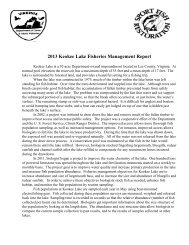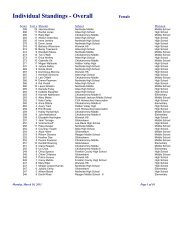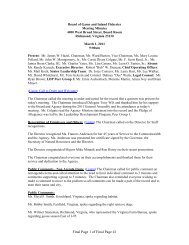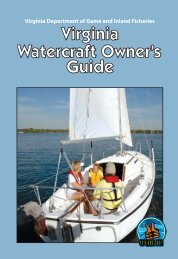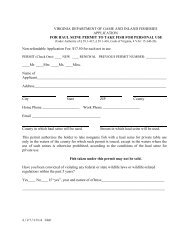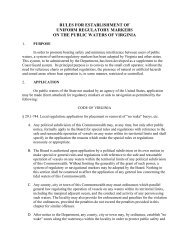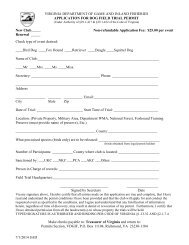2013 Virginia Freshwater Fishing & Watercraft Owner's Guide
2013 Virginia Freshwater Fishing & Watercraft Owner's Guide
2013 Virginia Freshwater Fishing & Watercraft Owner's Guide
Create successful ePaper yourself
Turn your PDF publications into a flip-book with our unique Google optimized e-Paper software.
<strong>2013</strong> <strong>Fishing</strong> Regs & WOG 11-15-12_Layout 1 11/16/12 1:02 PM Page 67America’s Waterway WatchAmerica’s coasts, rivers, bridges, tunnels,ports, ships, military bases, and watersideindustries may be the terrorists’ next targets.If you see outwardly suspicious activity,or even behavior that makes you uneasy,please report it. Here are things to look for:• Unattended vessels or vehicles inunusual locations.• Unusual night operations.• Recovering or tossing items into/ontothe waterway or shoreline.• Operating in or passing through an areathat does not typically have such activity.• Missing fencing or lighting near sensitivelocations.• Transfer of people or items betweenvessels, or between vessels and theshore outside of a port.• Anyone operating in an aggressivemanner.• Small planes flying over critical locations.• Persons attempting to buy or rent fishingor recreational vessels with cash forshort-term, undefined use.• Other suspicious activity.Call the National Response Center at877-24WATCH or 911 to report suspiciousactivity.Boat Theft PreventionWhen Buying a Boat• Be careful because it could be stolen.• Be certain that the boat’s descriptionon the title matches the boat you arebuying. Check year, make, length, andhull identification number.• Be sure the model and serial numberon an outboard motor have not beenremoved, tampered with or altered.• Be suspicious of a fresh paint job on alate model vessel.• When buying a used vessel, try to dealwith a reputable marine dealer or abroker licensed by the state.• If the price seems too good to be true,there is a good chance that the boat isstolen.Equipment Identification• Mark all equipment when purchased.• If your boat was built before 1972, it maynot have a hull identification number.• It is a good idea to inscribe that registrationnumber onto some unexposedlocation on the interior of your boat.• Document Boat contents.• Store gear/electronics when not in use.Trailerable BoatsStealing a boat is much easier if a thief canhitch up to your boat on a trailer and driveaway. These tips may help.• If possible, store the boat and trailer in alocked garage.• Store boats in the back or side yard outof sight.• Store the boat with the trailer tongue noteasily accessible.• Park another vehicle or other largeobject in front of the trailer.• Remove one trailer wheel.• Purchase a good quality trailer hitch lockand use it—even if stored inside.Vessel SecurityThere are several things that can be done toreduce the risk of vessel theft.• Lock Marine Hatch.• Lock the Forward Hatch.• Lock Windows.Report ItIf your boat, trailer or gear is missing,report it immediately to the followinggroups. Use your written and photographicmarine record to give specific and completeinformation.• Local law enforcement agencies.• Your insurance company.• Department of Game and InlandFisheries.• The dock or harbormaster.• Neighboring boaters.• Local newspapers.Carbon MonoxideCarbon monoxide is an odorless, colorless,tasteless gas that can be toxic in small quantities.It is produced by engines, generators,grills, and other equipment commonly usedby boaters. Every year people who recreateon and around boats are overcome by theeffects of carbon monoxide.Recreational boaters need to be awareof carbon monoxide poisoning preventionpractices such as regular professional boatinspections; the installation and maintenanceof carbon dioxide detectors in livingspaces; the hazards of “platform dragging;exhaust leaks from CO sources, specific boatdesign features of concern (especiallyhouseboats); and the danger of swimmingnear the stern of the watercraft while generators,engines or other carbon monoxideproducing equipment is in operation.Capsizings and FallsOverboardCapsizings and falls overboard are theleading cause of fatal boating incidents. Tohelp lessen the chance of capsizing or fallingoverboard, follow these basic safety tips:• Always wear your life jacket.• Stay low in the boat and maintain 3points of contact. Keep 2 feet and 1hand, or 2 hands and 1 foot in contactwith the boat at all times. If seated, youhave one point of contact on the seat,and still need to maintain 2 others—suchas 1 foot, 1 hand, 2 feet, etc.• When loading supplies into a boat, haveone person get into the boat and thenhand that person the supplies.• If retrieving an item from the water,maneuver the boat close to the objectand use a boathook or paddle. If you doneed to reach outside the hull of theboat, keep 3-points of contact.• Keep an even, balanced load.• Do not attach the anchor line to the sternof the boat.• When pulling up the anchor, stay low inthe boat and well balanced.• If in rough waters, head the bow of theboat anywhere from directly into theseas up to a 45 degree angle dependingon sea state and vessel construction.• Follow the information stated on the“Capacity Plate.” Never exceed theallowable weight, horsepower rating,or maximum number of people.Enjoying the WaterTowed Sports SafetyThe boating law contains several provisionsrelating to the towing of persons on waterskis, aquaplanes, and similar devices; andthe manipulation of such devices by theperson being towed.1. All boats towing a water skier(s) or otherpersons on towed devices MUST haveONE of the following:a. Persons being towed must be wearinga USCG approved life jacket or67



